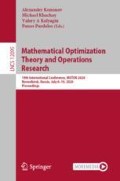Abstract
In this paper, we propose a novel approach to recovering path relationships in communication networks. The path relationship is one of the key input data which is necessary for network operation and maintenance. We have a continuous network transformation, upgrades, expansions, service allocations, thus the network physical topology and paths relationship are permanently changing with high frequency. Our approach is aimed at recovering the path relationships through flow information of each arc in the network. Getting the flow information is not a big technical problem and its control is included in the basic toolbox for network monitoring. We consider two scenarios which lead us to integer linear programs. The both of them minimize the flow deviation, where in the first one we look for a directed spanning tree (r-arborescence) and, in the second one—more general origin/destination paths (OD-paths). We propose mixed integer linear programming formulations for both problems. Their feature is that they contain the non-polynomial number of constraints which are considered implicitly by the cutting planes approach. The preliminary computation results showed that the large-scale instances of the first scenario can easily be solved. At the same time, the optimal solutions of second scenario problems can be found only on small- and medium-size instances, which inspires for the further research.
Access this chapter
Tax calculation will be finalised at checkout
Purchases are for personal use only
References
Abadi, A., Rajabioun, T., Ioannou, P.A.: Traffic flow prediction for road transportation networks with limited traffic data. IEEE Trans. Intell. Transp. Syst. 16(2), 653–662 (2015). https://doi.org/10.1109/TITS.2014.2337238
Akyildiz, I.F., Lee, A., Wang, P., Luo, M., Chou, W.: A roadmap for traffic engineering in SDN-openflow networks. Comput. Netw. 71, 1–30 (2014). https://doi.org/10.1016/j.comnet.2014.06.002
Altın, A., Yaman, H., Pınar, M.C.: The robust network loading problem under hose demand uncertainty: formulation, polyhedral analysis, and computations. INFORMS J. Comput. 23(1), 75–89 (2011). https://doi.org/10.1287/ijoc.1100.0380
Applegate, D.L., Bixby, R.E., Chvatál, V., Cook, W.J.: The Traveling Salesman Problem: A Computational Study. Princeton University Press, Princeton (2006). http://www.jstor.org/stable/j.ctt7s8xg
Avella, P., Boccia, M., Sforza, A., Vasil’ev, I.: A branch-and-cut algorithm for the median-path problem. Comput. Optim. Appl. 32(3), 215–230 (2005). https://doi.org/10.1007/s10589-005-4800-2
Avella, P., Mattia, S., Sassano, A.: Metric inequalities and the network loading problem. Discrete Optim. 4(1), 103–114 (2007). https://doi.org/10.1016/j.disopt.2006.10.002. Mixed Integer Programming
Beasley, J.E.: An algorithm for the steiner problem in graphs. Networks 14(1), 147–159 (1984). https://doi.org/10.1002/net.3230140112
Benhamiche, A., Mahjoub, A.R., Perrot, N., Uchoa, E.: Unsplittable non-additive capacitated network design using set functions polyhedra. Comput. Oper. Res. 66, 105–115 (2016). https://doi.org/10.1016/j.cor.2015.08.009
Bharath-Kumar, K., Jaffe, J.: Routing to multiple destinations in computer networks. IEEE Trans. Commun. 31(3), 343–351 (1983). https://doi.org/10.1109/TCOM.1983.1095818
Cheng, X., Li, Y., Du, D.Z., Ngo, H.Q.: Steiner trees in industry. In: Du, D.Z., Pardalos, P.M. (eds.) Handbook of Combinatorial Optimization, pp. 193–216. Springer, Boston (2005). https://doi.org/10.1007/0-387-23830-1_4
Dreyfus, S.E., Wagner, R.A.: The steiner problem in graphs. Networks 1(3), 195–207 (1971). https://doi.org/10.1002/net.3230010302
Goemans, M.X., Myung, Y.S.: A catalog of steiner tree formulations. Networks 23(1), 19–28 (1993). https://doi.org/10.1002/net.3230230104
Hakimi, S.L.: Steiner’s problem in graphs and its implications. Networks 1(2), 113–133 (1971). https://doi.org/10.1002/net.3230010203
Karbassi, A., Barth, M.: Vehicle route prediction and time of arrival estimation techniques for improved transportation system management. In: IEEE IV2003 Intelligent Vehicles Symposium, Proceedings (Cat. No. 03TH8683), pp. 511–516, June 2003. https://doi.org/10.1109/IVS.2003.1212964
Könemann, J., Pritchard, D., Tan, K.: A partition-based relaxation for steiner trees. Math. Program. 127(2), 345–370 (2011). https://doi.org/10.1007/s10107-009-0289-2
Novak, R., Kandus, G.: Adaptive steiner tree balancing in distributed algorithm for multicast connection setup. Microprocess. Microprogr. 40(10), 795–798 (1994). https://doi.org/10.1016/0165-6074(94)90042-6
Novak, R., Rugelj, J., Kandus, G.: Steiner Tree Based Distributed Multicast Routing in Networks, pp. 327–351. Springer, Boston (2001). https://doi.org/10.1007/978-1-4613-0255-1_10
Oliveira, C.A., Pardalos, P.M.: Mathematical Aspects of Network Routing Optimization. SOIA, vol. 53. Springer, New York (2011). https://doi.org/10.1007/978-1-4614-0311-1
Polzin, T., Daneshmand, S.V.: On steiner trees and minimum spanning trees in hypergraphs. Oper. Res. Lett. 31(1), 12–20 (2003). https://doi.org/10.1016/S0167-6377(02)00185-2
Rathore, P., Kumar, D., Rajasegarar, S., Palaniswami, M., Bezdek, J.C.: A scalable framework for trajectory prediction (2018). https://arxiv.org/abs/1806.03582v3
Resende, M., Pardalos, P.: Handbook of Optimization in Telecommunications. Springer, Heidelberg (2008). https://doi.org/10.1007/978-0-387-30165-5
Siebert, M., Ahmed, S., Nemhauser, G.: A linear programming based approach to the steiner tree problem with a fixed number of terminals. Networks 75(2), 124–136 (2020). https://doi.org/10.1002/net.21913
Voß, S.: Steiner tree problems in telecommunications. In: Resende, M.G.C., Pardalos, P.M. (eds.) Handbook of Optimization in Telecommunications, pp. 459–492. Springer, Boston (2006). https://doi.org/10.1007/978-0-387-30165-5_18
Author information
Authors and Affiliations
Corresponding author
Editor information
Editors and Affiliations
Rights and permissions
Copyright information
© 2020 Springer Nature Switzerland AG
About this paper
Cite this paper
Vasilyev, I., Zhang, D., Ren, J. (2020). Integer Programming Approach to the Data Traffic Paths Recovering Problem. In: Kononov, A., Khachay, M., Kalyagin, V., Pardalos, P. (eds) Mathematical Optimization Theory and Operations Research. MOTOR 2020. Lecture Notes in Computer Science(), vol 12095. Springer, Cham. https://doi.org/10.1007/978-3-030-49988-4_31
Download citation
DOI: https://doi.org/10.1007/978-3-030-49988-4_31
Published:
Publisher Name: Springer, Cham
Print ISBN: 978-3-030-49987-7
Online ISBN: 978-3-030-49988-4
eBook Packages: Mathematics and StatisticsMathematics and Statistics (R0)

